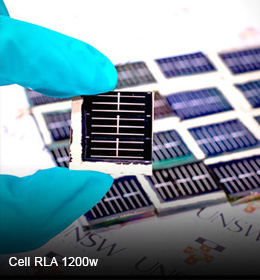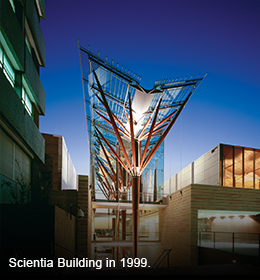UNSW's 70th Anniversary
1990s

Solar Research
1998 UNSW was well on its trajectory to make headlines around new renewable innovation. In 1998, UNSW labs set a global record for photovoltaic cells at 25% efficiency. The research team behind this feat discovered new ways to control hydrogen atoms and correct deficiencies in Silicon, the most costly materials in solar photovoltaic cells, benefiting renewable solar energy solutions globally at affordable prices.
Today In 2014, solar engineers from UNSW's Australian Centre for Advanced Photovoltaics have set a new world-record in solar energy efficiency, achieving an electricity conversion rate of over 40%. The 40% efficiency milestone is the latest in a long line of achievements by UNSW solar researchers spanning four decades under the leadership of UNSW research star Scientia Professor Martin Green AO, known widely as ‘the father of photovoltaics’.

Scientia Professors
1997 The UNSW Council established the Scientia Professorships. Initially intended to be for visiting professors, in December 1997 the scheme was extended "to members of the full-time academic staff of the University in recognition of extraordinary and outstanding research". This new criteria has come to be synonymous with the scheme. The first group of six full time Scientia professors took up their appointments on 1 January 1999.
Today We now have around 60 active Scientia Professors, leading on major research projects with global impact. This includes Scientia Professor Veena Sahajwalla, from UNSW’s Centre for Sustainable Materials Research and Technology (‘SMaRT@UNSW’). Professor Sahajwalla has pioneered technological developments that transform waste materials including glass, tyres and fabric into building materials, and turn discarded phones into usable metal alloys and plastic filaments. The aim is to maximise the impact of technological breakthroughs through productive cross-sector collaborations.

Scientia Building
1999 The Scientia Building was constructed in the late ’90s– later renamed the John Niland Scientia Building in 2006 after UNSW’s former Vice-Chancellor and alumnus for his fundraising efforts towards the Scientia Appeal – a fundraising appeal in support of the building’s construction, which was launched in 1997. The building fast became a prominent icon of UNSW, sitting high above the University mall with fantastic views of campus. It also represents one of first buildings at UNSW to be created as a result of philanthropic giving.
Today While the sleek John Niland Scientia Building overlooks still stands in the heart of the Kensington campus, UNSW continues to fundraise to develop and modernise campus to ensure we provide world-class environments for students, staff and the community. We have been fortunate to attract with generous contributions from a number of donors resulting in the newly renovated UNSW Roundhouse, the Ainsworth Engineering Building, and the award-winning Tyree Energy Technologies Building. At the heart of our revitalised future campus will also be Alumni Park, a green space reflecting the pride and achievements of our alumni.
All photos have been provided by UNSW Archives.
